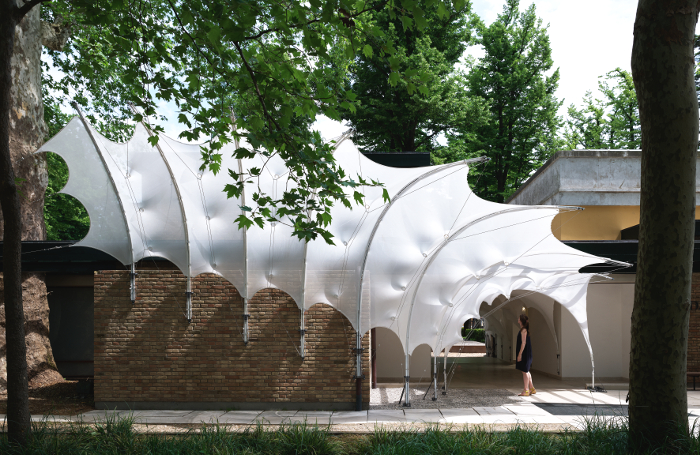Digital tools are enabling increasing innovation to be made in architectural design. Given the challenges that face today’s built environment on a global scale, such tools will play an essential part in providing sustainable solutions.
Mette Ramsgaard Thomsen is an architect and researcher investigating how computation, code, material and fabrication challenge architectural thinking and material practices.
She is a Professor at Denmark’s Centre for Information Technology and Architecture (CITA), which engages in research and cross-disciplinary industry collaboration with numerous different partners.
"We all know that architects are building for a huge number of people in the future," Thomsen states. "This is compounded by the fact that, globally, we are running out of materials."
"Industrial fabrication has focused on very specific materials. We do not have an infinite amount of sand for concrete, for example."
There is indeed a finite supply of today’s traditional building materials (or their elemental components), as made visible in the periodic table of endangered materials.
Accordingly, Thomsen describes the goals of her work as twofold. Firstly, there is the importance of hyper-optimisation of materials; or, as she puts it, "how to work smarter with less". Secondly, she considers it imperative that we rethink the materials we are working with.
The team of students and researchers at CITA has produced a fascinating portfolio of work that has scrutinised and tested materials in order to energise their properties in new ways.
It engages with new materials, such as bio-polymers; it investigates how to employ textiles in structures; and seeks to optimise conventional materials, such as steel.
CITA’s project A Bridge Too Far took thin panelised metal skins, typically used as a non-structural cladding material, and successfully increased its structural capacity, its rigidity in particular.
Dermoid investigated how clusters of small building elements could construct vaults. It was based on a reciprocal truss-frame system that exploits the bending capabilities of plywood. This kind of research that offers radical new possibilities for the designs of the future.
"If we want to work in a way that optimises materials, we need to understand their embedded performance, such as the tensioning of textiles," Thomsen asserts. "We need to integrate simulation early in the design chain."
It is computer technology that allows such a radical questioning and re-visioning of materials. Talk of using simulations in design inevitably brings to mind Building Information Modelling (BIM).
"It is information modelling, so it is BIM in one sense, but we do not work within the Industry Standard Toolset (IST) codes, because they specify consolidated practices; methods that are known," explains Thomsen.

Computation of this unconventional kind has facilitated Thomsen’s research into the use of textiles, and the lessons from traditional crafts that allow textiles to be re-employed in architectural structures.
"There has always been a relationship tween architecture and craft: the Arts and Crafts and the Bauhaus movements, for example," Thomsen points out. "Materials are not passive and this is embodied in craft knowledge."
"We understand textile principles at the scale of the body – in the context of a sweater or skirt. If we want to work at a large scale we need to formalise these. Integrated computer simulation early in the design allows this."
Lightweight structures are another area in which CITA is conducting pioneering research.
"When we think of the economies of fabrication and transportation, it is important to consider what lighter building practices could provide," she suggests.
"A lighter impact is an important consideration both in the quantity of materials used and in the intelligent performance of structures. Rather than thinking of materials as universal and given, could we instead try to develop materials that are use- or site-specific?"
This is, as she puts it, a bottom-up approach: developing materials in such a way that their performance can be "pre-designed".
While some of this work might seem abstract, it is linked to problems that are very concrete. The built environment is increasingly focused on questions concerning the life-cyle of buildings, their adaptability and of course their carbon footprint.
"These models allow us to think about how we can apply their principles in material systems that are much more architecturally appropriate," Thomsen states.
Mette Ramsgaard Thomsen is the keynote speaker at the Smart Practice Conference 2019: New Ways of Working on 1 October 2019 at the RIBA, 66 Portland Place, London, W1B 1AD. Tickets are now available.
Thanks to Mette Ramsgaard Thomsen, Professor, Royal Danish Academy of Fine Arts.
Text by Matt Milton. This is a Professional Feature edited by the RIBA Practice team. Send us your feedback and ideas
RIBA Core Curriculum Topic: Sustainable Architecture.
As part of the flexible RIBA CPD programme, Professional Features count as microlearning. See further information on the updated RIBA CPD Core Curriculum and on fulfilling your CPD requirements as an RIBA Chartered Member.









